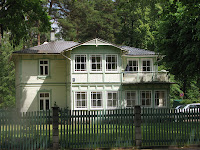Prague is another one of those places where the Brits take cheap flights to for their hen and stag weekends because it is famous for its beer!
Of all the places we have visited so far, Prague has had the most graffiti. Someone had written "We don't want a clean city" in big black letters along a wall. We noticed a lot of swear words in English and I'm sure if we spoke Czech we would have seen a lot more in that language.
There seemed to be twice as many street people talking to themselves, urinating into rubbish bins, sitting around drinking alcohol, scavenging for food in the bins, sleeping in the parks, and begging, than we have seen anywhere else.

Beside the main square were horses and carts waiting to take tourists around the old city sights.

There was this young man looking for passengers to peddle their way around the narrow cobbled streets with him on his mobile bar.

There was also a larger version of this where you could cycle your way around on a pub crawl- perfect for those hen and stag groups.

On the hour crowds of people wait in front of the astronomical clock for it to chime.

Prague Castle is inundated with throngs of tourists and is the world's biggest castle complex- like a small town really.


Visited a restaurant for some traditional goulash.

We did lots of walking in the city and enjoyed some of the parks with their great views over the city.

Charles Bridge was built in 1357 and was the only city bridge till 1841. It is crammed with artists sketching caricatures, buskers, jewelery sellers and tourists looking for bargains. Half of the bridge is being renovated at present. There are about 30 old statues along the bridge that seem to have survived without being covered with graffiti!

We were in the city square for the final of the Euro 08 football where the Spanish beat the Germans. There were several bands playing before the game and a huge screen was set up so everyone could watch the game. Tents selling beer were around the sides of the square and 3 people were kept busy grilling kebabs and sausages for the hordes. It was a fun night. We were cheerimg for Spain!










































